/
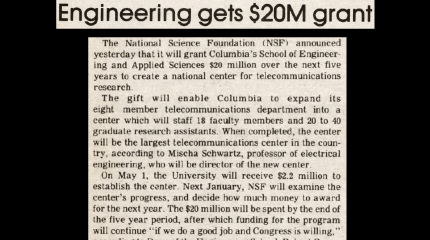
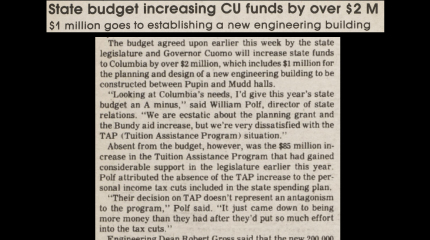
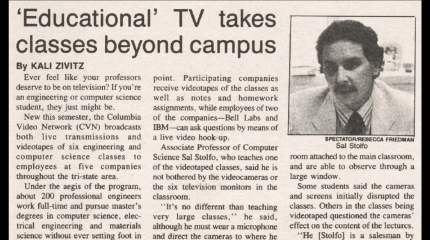
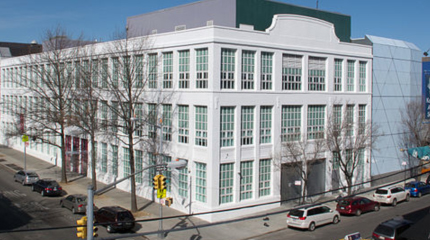
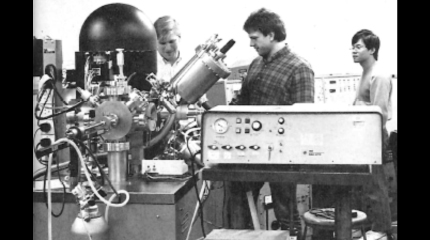
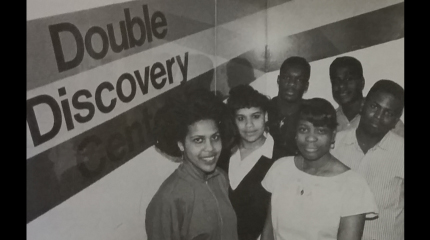
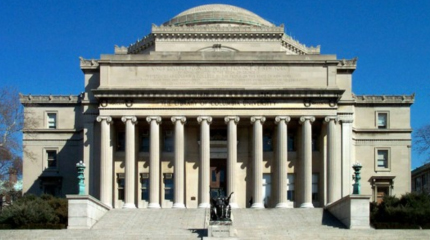
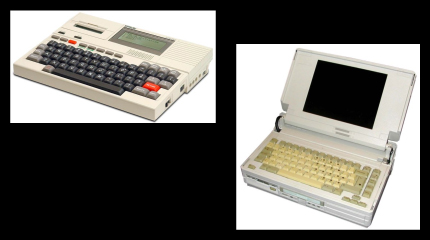
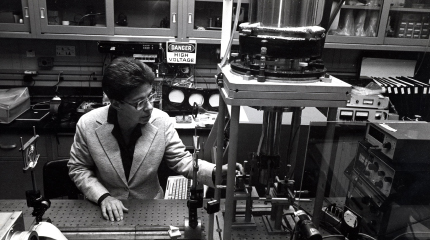
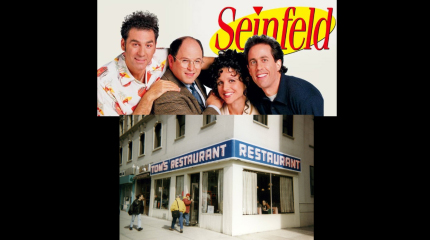
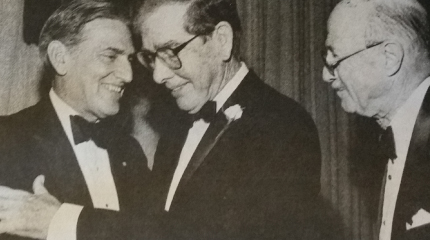
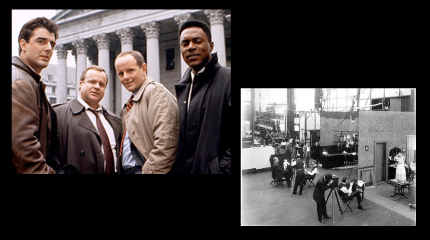
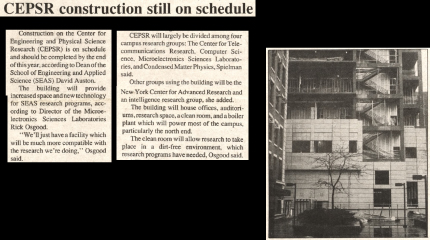
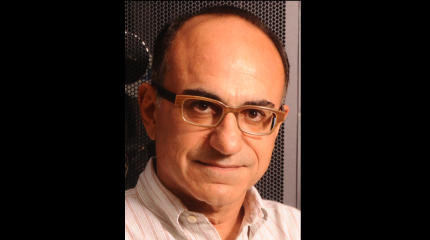
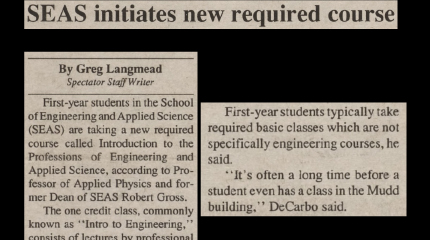
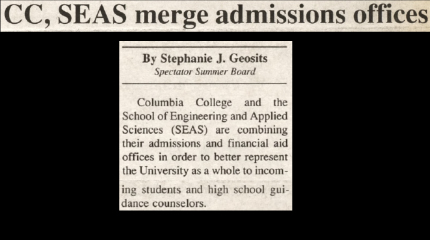
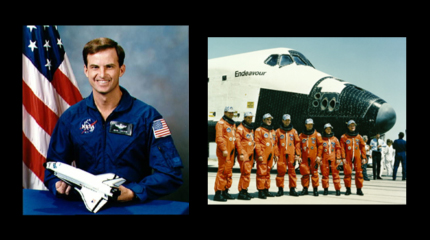
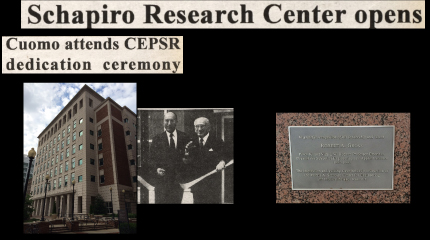
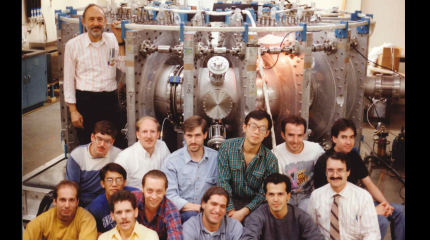
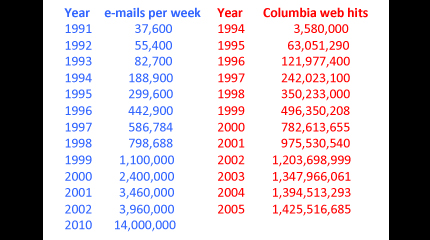
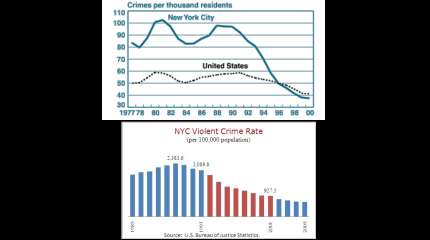
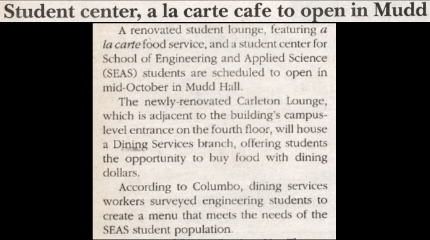
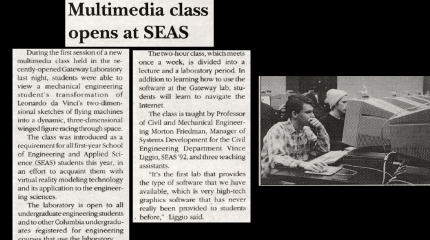
/
SEAS faculty are awarded a grant from the National Science Foundation to establish the Center for Telecommunications Research (CTR), as reported in the April 4, 1985 Spectator. This is among the first of several large centers established in SEAS and between SEAS and other schools at Columbia, and helps the school grow and excel.
New York State gives money to help Columbia plan and design a new engineering building between Mudd and Pupin, as reported in the April 5, 1985 Spectator. This leads to building the Schapiro Center for Engineering and Physical Science Research (CEPSR).
1986—SEAS launches the pioneering Columbia Video Network, CVN, in the fall semester. This helps SEAS meet the post-undergraduate learning needs of those in industry without needing to send faculty to teach off site. Students can earn master's degrees without coming to campus. CVN is initially offered to corporations within 75 miles, usually by sending the VHS tapes recorded by the faculty teaching on-site students. The program expands and adapts to new changes in distribution technology. Shown, the Sept. 24, 1986 Spectator article on CVN.
September 10, 1988—The American Museum of the Moving Image opens in Astoria, Queens. It is devoted to the art, history, technique, and technology of film, television, and digital media. It is later renamed The Museum of the Moving Image. Shown, in 2011 after renovation.
Complex laboratory instrumentation is increasingly used to probe and modify materials, such this ultra-high vacuum surface science apparatus in which samples can be irradiated by an excimer laser; photo from the 1988 Columbia Engineer yearbook. This work helps usher in the era of microelectronics science and nanoscience research in SEAS.
Created in 1965 by Columbia undergraduates, Double Discovery works to help students from under-served backgrounds pursue higher education. Columbia students help 12- to 17-year-olds graduate high school, enroll and succeed in college, and prepare for careers and responsible adulthood. SEAS involvement is highlighted in the Winter 1988 Engineering News; the photo is from that issue.
The University administration (“Low Library”) adopts a new business model in the late 1980s, in which each school is a quasi-independent revenue and expense center. While initially thought to be hurtful to SEAS, it proves to be one of the engines that enables great progress in SEAS beginning in the 1990s.
Laptops and portable computers take off. Shown: Epson HX-20 portable computer, the first laptop and portable computer, in 1981; Compaq SLT/286, with the first VGA screen, in 1988, which costs $5,399 in 1990.
1988—Prof. Gertrude Neumark develops the process of non-equilibrium doping that enables great improvements in light-emitting and laser diodes, particularly in the blue-green region. Her 1990 and 1993 patents are used by many companies for improving consumer products, including sharper laser printers, increased DVD storage capacity, advanced traffic lights, mobile phone screens, and flat-screen TVs.
1989—Seinfeld begins its first of nine seasons portraying the unusual life of “prototypical New Yorkers.” Tom's Restaurant, a diner at 112th Street and Broadway, is used as the exterior image of Monk's Café in the show. It is the ground floor of Columbia University's Armstrong Hall (named after the legendary SEAS professor Edwin H. Armstrong), which houses NASA GISS (Goddard Institute for Space Science)—which has long-standing strong ties with SEAS and APAM.
1989—Celebration of the SEAS 125th anniversary at the Waldorf-Astoria, as reported in the Winter 1989 Engineering News, with Columbia Engineering School Alumni Association (CESAA) President Guy Longobardo and Egleston medalists Weldon S. Booth and Seymour J. Sindeband.
New York City, long a magnet for movie and TV show production, sees increasing filming on the streets of New York. 1990—Law & Order, beginning the first of its 20 seasons, is part of this renaissance. When gunfire is heard on the streets of New York, it may well be because Law & Order is being filmed.
Construction of the Center for Engineering and Physical Science Research (CEPSR) is underway, as reported in the Jan. 25, 1991 Spectator.
1991—The research of Prof. Dimitris Anastassiou (shown) and Ph.D. student Fermi Wang ’91 becomes part of a key MPEG-2 patent that is instrumental in implementing international video standards broadly used in digital video, DVD, and Blu-Ray.
SEAS students had typically taken courses exclusively at Columbia College during their first two years. To introduce them to SEAS earlier, a new course is developed, “Introduction to the Professions of Engineering and Applied Science,” which is required of all first-year SEAS students, as reported in the Feb. 1, 1991 Spectator. The course is offered for only a few years before it is replaced by other programs with the same goal.
The separate undergraduate admissions offices of SEAS and Columbia College merge, as reported in the July 1, 1992 Spectator. This enables integrated recruitment, while maintaining distinct admitted classes for the two schools. The change increases the number of applications and the admissions selectivity and yield for both schools.
1992—Kevin Patrick "Chilli" Chilton (MS'77 in mechanical engineering) is due to pilot flight STS-49, the maiden voyage of Space Shuttle Endeavour in May 1992 (second from the left in the righthand photo), as reported in the Spring 1992 Engineering News (and noted in the Winter 1993 Eng. News). He was also on two later space shuttle flights: STS-59, as pilot on the Space Radar Laboratory (SRL) mission (April, 1994), and STS-76, as commander on the third docking mission to the Russian space station Mir in 1996, and overall logged more than 704 hours in space. Chilton was promoted to the rank of four-star General in the U.S. Air Force, and was Commander, U.S. Strategic Command from 2007 to 2011.
1992—Schapiro CEPSR is dedicated, as reported in the Sept. 17, 1992 Spectator. Morris A. Schapiro CC‘23 and SEAS‘25 donated $10M toward CEPSR construction (and in 1988 he helped build the Schapiro Dormitory). New York State helped to finance CEPSR with grants and loans. Dean Robert Gross spearheaded the CEPSR project (dedication on right).
1993—The High Beta Tokamak-Extended Pulse (HBT-EP) is completed by Profs. Gerald Navratil and Michael Mauel. It is the third and largest in a series of tokamaks built at Columbia. Tokamaks are torus-shaped reactors in which plasmas are confined by magnetic fields; they are promising as fusion energy reactors.
The internet takes off at Columbia. Jan.-Apr. 1994—The Columbia website debuts. Summer 1994—Most residence halls are wired for Ethernet: Carman, Furnald, Hartley, John Jay, Wallach (Livingston), and Wien (Johnson). The first electronic classrooms are set up.
In the early 1990s the rates of crime and violent crime in New York City begin to plummet.
The opening of the Mudd café is part of a campus-wide decentralization of eateries of campus, a departure from student eating areas being exclusively in dormitories, as reported in the Oct. 3, 1994 Spectator.
The Gateway lab opens, as reported in the Nov. 15, 1994 Spectator. The Gateway lab is home to a new multimedia course required for first-year SEAS students.